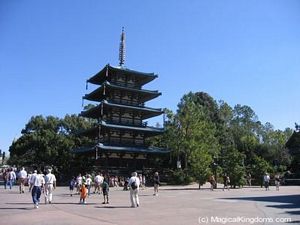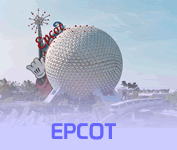
JAPAN PAVILION AT EPCOT
|
|

Along the shoreline of the lagoon, a bright red torii gate, patterned after one in Itsukushima, welcomes visitors. A plaque inscribed in calligraphy proclaims "Japan."
Near the open-air entrance to the grounds stands the blue-roofed, five-story Goju-no-to pagoda, inspired by a shrine built at Nara in 700 A.D. Topping it is a bronze, nine-ringed sorin, or spire, with gold wind chimes and a water flame.
An oasis of serenity extends from the pagoda: a hill garden which is a Japanese art form at least 1,000 years old.
Careful arrangements of waterfalls, rocks, flowers, lanterns, pebbles, foot paths and rustic bridges form a story. Multicolored koi fish in the pond create living images of Japanese art.
Further west, to the right of the courtyard, stands the Shishinden, inspired by the ceremonial and coronation hall found in the Imperial Palace grounds at Kyoto.
On the east side of the courtyard stands the Yakitori House, a small version of the
Shoken-tei in the Kyoto Imperial Villa gardens. This rustic building with its thatched roof serves as a restaurant, offering Japanese snacks and refreshments.
The massive wood and stone Nijo entry castle with its huge sculptures of mounted samurai warriors beckons guests through the courtyard.
Passing through it, visitors cross a wide bridge spanning a moat to the Himeji or White Heron Castle with its curved stone walls, white plaster structures and blue tile roofs. Its style dates from the mid 1300s.
Attractions
 Bijutsu-kan Gallery - Features continuously changing exhibits which reflect the culture and history of Japan Bijutsu-kan Gallery - Features continuously changing exhibits which reflect the culture and history of Japan
 Matsuriza Matsuriza
 Miyuki Miyuki
 Pal
Mickey Interaction Pal
Mickey Interaction
Dining
 Teppanyaki Dining Rooms Teppanyaki Dining Rooms
 Tempura Kiku Tempura Kiku
 Matsu No Ma lounge Matsu No Ma lounge
 Yakitori House Yakitori House
Shopping
 Mitsukoshi Department Store - Ornate kimonos, Japanese toys and dolls, bonsai trees, authentic Mikimoto pearl jewelry and more. Mitsukoshi Department Store - Ornate kimonos, Japanese toys and dolls, bonsai trees, authentic Mikimoto pearl jewelry and more.
|
 |
Tips & Fun Facts
 Be sure to take the time to explore some of the often missed areas of the Japan pavilion, such as the serene garden area or the Bijutsu-kan gallery. Be sure to take the time to explore some of the often missed areas of the Japan pavilion, such as the serene garden area or the Bijutsu-kan gallery.
 The restaurants and shops are presented by Mitsukoshi, one of the oldest and largest department stores in the world (founded in 1673). The restaurants and shops are presented by Mitsukoshi, one of the oldest and largest department stores in the world (founded in 1673).
 The structure which houses the Mitsukoshi Department Store on the first floor and a formal Japanese restaurant on the second was inspired by a portion of the Gosho Imperial Palace in Kyoto. The structure which houses the Mitsukoshi Department Store on the first floor and a formal Japanese restaurant on the second was inspired by a portion of the Gosho Imperial Palace in Kyoto.
 The levels of the five-tiered pagoda represent the five elements from which Buddhists believe all things in the universe are produced: earth, water, fire, wind and sky. It was modeled after an 8th-century structure in Japan. The levels of the five-tiered pagoda represent the five elements from which Buddhists believe all things in the universe are produced: earth, water, fire, wind and sky. It was modeled after an 8th-century structure in Japan.
 Most of the plants are stand-ins for the actual Japanese varieties, since few Japanese plants could survive the Florida climate. Most of the plants are stand-ins for the actual Japanese varieties, since few Japanese plants could survive the Florida climate.
 The castle in Japan is a replica of the Shirasagi-Jo, a 17th century fortress overlooking the city of Himeji, known as one of the most well-preserved castles in Japan. The castle in Japan is a replica of the Shirasagi-Jo, a 17th century fortress overlooking the city of Himeji, known as one of the most well-preserved castles in Japan.
Related Links
 Google
Maps Google
Maps
 Park Map Park Map
 Photos Photos
|


